
People appropriate their home in three ways: By familiarising, organising, and managing their environment. Familiarising consists of what is home, which activities are shared, how the space is personalised, and the objects that are owned. Organising deals with meaningful objects, how the space is filled, what are the favourite activities, and how the dinner table is used. Managing concerns cleanliness of the space, how the indoor environment is perceived, and what is done to achieve comfort.
These three themes tell us what someone does in their dwelling place to make it more like home, but also what someone would like to do and how the place can limit someones behaviour. Designers of homes can learn from this that it is important to consider different types of behaviours and how these behaviours contribute to what makes a house into a home for someone.
More attention could be paid to where people can put furniture they already own, to how spaces can be rearranged by the dweller to facilitate different activities, and where objects can be put away if they are not meant to be seen. Lastly, there appear to be many ways in which the indoor environment is controlled, depending on the activity. Flexibility in making quick adjustments would be an important aspect that should be kept in mind when designing sustainable buildings that depend on mechanic systems rather than hands on methods for environmental control.
Overtoom, M. E., Elsinga, M. G., & Bluyssen, P. M. (2023). Experiencing Temporary Home Design for Young Urban Dwellers:“We Can’t Put Anything on the Wall”. Buildings, 13(5), 1318.
